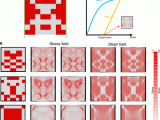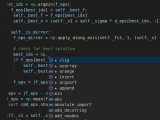
New AI tool calculates stress and strain of materials from photos
27. April 2021New AI tool calculates stress and strain of materials from photos
New York, 4/27/2021
MIT researchers have developed a technique to quickly determine certain material properties, such as stress and strain, using an image of the material that shows its internal structure. This approach could one day eliminate the need for tedious physical calculations, relying instead on computer vision and machine learning to generate estimates in real time.
The researchers say this advance could enable faster design prototyping and material inspection. „It’s a completely new approach,“ Zhenze Yang points out, adding that the algorithm „performs the whole process without any physical expertise.“
The research appeared in the journal Science Advances. Yang is the lead author of the paper and a doctoral student in the Department of Materials Science and Engineering. Co-authors include former MIT postdoctoral fellow Chi-Hua Yu and Markus Buehler, the McAfee Professor of Engineering and director of the Laboratory for Atomistic and Molecular Mechanics.
https://advances.sciencemag.org/content/7/15/eabd7416
The background: engineers spend a lot of time solving equations. They help determine the internal forces of a material, such as stress and strain, that can cause it to deform or break. Such calculations can indicate how a proposed bridge would hold up under heavy traffic loads or high winds. Engineers don’t need a pen and paper for this task. „Many generations of mathematicians and engineers have written down these equations and then figured out how to solve them on a computer,“ Buehler says. „But it’s still a difficult problem. It’s very expensive – it can take days, weeks or even months to do some simulations. So we thought: Let’s teach an AI to solve this problem for us.“
The researchers turned to a machine learning technique called a generative adversarial neural network. They trained the network with thousands of paired images – one showing the internal microstructure of a material subjected to mechanical forces, and the other showing the color-coded stress and strain values of the same material. With these examples, the network uses principles of game theory to iteratively figure out the relationships between a material’s geometry and the resulting stresses.
„So the computer is able to predict all these forces from one image: the deformations, the stresses and so on,“ Buehler says. „That’s really the breakthrough – in a conventional way, you would have to code the equations and ask the computer to solve partial differential equations. We just go from image to image.“
This image-based approach is particularly beneficial for complex, composite materials. The forces acting on a material may be different on the atomic scale than on the macroscopic scale. But the researcher’s network is adept at dealing with multiple scales. It processes information through a series of „convolutions“ that analyze images at increasingly larger scales. „That’s why these neural networks are excellent for describing material properties,“ Buehler says.
The fully trained network performed well in tests, successfully reproducing stress and strain values based on a series of close-up images of the microstructure of various soft composites. The network was even able to detect „singularities,“ such as cracks that develop in a material. In these cases, forces and fields change rapidly over tiny distances. „As a materials scientist, you would want to know if the model could replicate these singularities,“ Buehler says. „And the answer is yes.“
The advance could „significantly reduce the iterations required to design products,“ says Suvranu De, a mechanical engineer at Rensselaer Polytechnic Institute who was not involved in the research. „The end-to-end approach proposed in this work will have a significant impact on a wide range of engineering applications – from composites used in the automotive and aircraft industries to natural and man-made biomaterials. It will also have significant applications in pure scientific research, as the force plays a critical role in a surprisingly wide range of applications, from micro/nanoelectronics to cell migration and differentiation.“
The new technology not only saves engineers time and money, but could also give non-experts access to cutting-edge material calculations. Architects or product designers, for example, could test the feasibility of their ideas before passing the project on to an engineering team. „They can just draw their proposal and figure it out,“ Buehler says. „That’s a big deal.“
Once trained, the network runs almost instantly on consumer-grade computer processors. That could allow mechanics and inspectors to diagnose potential problems with machines simply by taking a picture.
In the new work, the researchers worked primarily with composite materials that included both soft and brittle components in a variety of random geometric arrangements. For future work, the team plans to use a wider range of material types. „I really think this method will have a big impact,“ Buehler says. „Empowering engineers with AI is really what we’re trying to do here.“
Funding for this research was provided in part by the Army Research Office and the Office of Naval Research.


